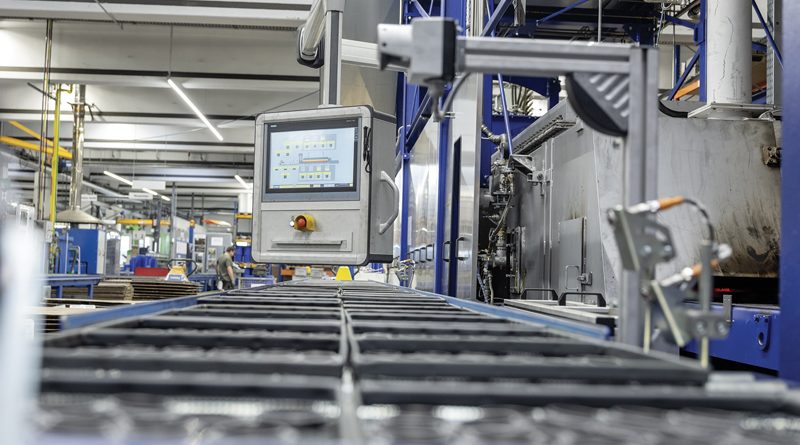A Production Network 4.0
Siemens supported an industrial group to deliver a modern infrastructure for the production network and the remote maintenance of machines and plants. It creates the basis for further networking within the company areas at the site
by Ginevra Leonardi
The story of the Simon Group began exactly 100 years ago, when Karl Simon finish components for the Black Forest clock industry and founded the company Simon. Today, three companies belong to the Group at its headquarters in Aichhalden. More than 750 employees produce a wide range of products and provide services: tools, furniture fittings, carbide tools, spikes, sintered components, injection molded plastict.
The infrastructure for the communication in the area of the production is provided by the Group as a central service to all affiliated companies: it’s important that the solution is flexible, but nevertheless uniform and above all future-proof. For this reason, Simon decided about two years ago to fundamentally put the systems in the production network and remote maintenance areas to the test. David Huber, plant engineering team leader at Simon, explains: “We had two areas in which we were looking for a more modern solution. On the one hand, we wanted to create a standardized, secure way for remote maintenance, and on the other, we wanted to improve the performance and availability of our entire production network”.
Special attention was paid to separate the production network for all plants at the site from the individual plant networks – in order to enhance network maintenance as well as increase network security. They needed a clear structure in which the plant components communicate within their cell, and only relevant data are transferred to the production network. This not only facilitates the maintenance and upkeep, but also makes the network more secure, since possible malfunctions are limited to one cell.
Detailed preparatory work and precise specification of the requirements
The Simon Group already utilizes Siemens products in many areas, and they wanted to employ standard solutions as much as possible to make the maintenance of the solution easier: together with the network experts from Siemens, they discussed the framework conditions, took stock of the existing network, and chose the appropriate configuration and corresponding components. The preparatory work and support provided by the Siemens Professional Services team facilitated the implementation. The commissioning ran flawlessly and the system works as intended. Simon can now integrate new plants and participants on its own – as was the plan.
Says Sven Ostertag, who is responsible for the modernization of the network technology in David Huber‘s team: “From the start, we made sure that the components were largely standardized and that a good documentation was compiled – and that pays off now. We’ve defined five types of switches, which we essentially only need to select and duplicate for a new plant. This also allows us to easily pass on knowledge internally”.
Secured and transparent communication
The new production network at Simon is based on an Industrial Ethernet ring, to which several rings with 32 Scalance XR524 switches are redundantly connected. For the management and diagnosis, Simon utilizes the Sinema Server software. For the connection of the subordinate plants, each possessing its own plant network, Simon uses the Scalance S615 Industrial Security appliance. It enables a secured access via VPN to the respective plant and at the same time shields the cell from the production network. “In my view, this cell protection concept is indispensable in the industrial environment” states Sven Ostertag. “In a networked production environment, this is the only way to ensure that malfunctions are limited to the respective cell. The technical possibilities provided by Scalance S615 allow us to virtually eliminate any vulnerabilities in the communication”. With Sinema Remote Connect as management platform for the secured remote access, plant engineering employees are also always fully aware of all VPN sessions.
Solid foundation for future developments
The new production network has now been in place for almost a year. Thanks to the ring structures of the network and the segmentation of the entire solution into individual plant networks, the entire network is much more reliable than before. For David Huber, especially the reliability of the devices are important arguments: “In many production areas, we’re dealing with harsh environmental conditions. Thanks to the extended temperature resistance of the Scalance components, we’ve no problems with that”. Possible faults and errors can be quickly identified in detail and be resolved with the Sinema Server management and diagnosis software. The simple maintenance of the new network also represents an important plus point. If a switch or router needs to be replaced, the employee can do this in just a few simple steps. The appropriate configuration is simply transferred from the old device by means of the C-Plug. This greatly reduces the workload. Because with the commissioning of the new production network, the job at Simon is far from complete. At present, not only are existing plants gradually integrated into the production network as well as new ones connected. Simon plans to connect the existing different systems for machine data as well as production data acquisition and for manufacturing execution system information with a common database. Says Tobias Hilgert, the managing director of technology at the Simon Group: “The digitalization and automation of our processes are important instruments for the continuation of our success. In Aichhalden, we’re currently building a new production hall, where we want to further increase the degree of automation, which includes innovative approaches such as data mining, for further improving the efficiency and quality of our processes. On the one hand, we need data from the production, on the other hand the appropriate infrastructure and right tools to capture and evaluate these data. And of course, the knowledge of our employees, but we also need capable partners that can broadly support us. With Siemens, we’ve found such a partner”.

